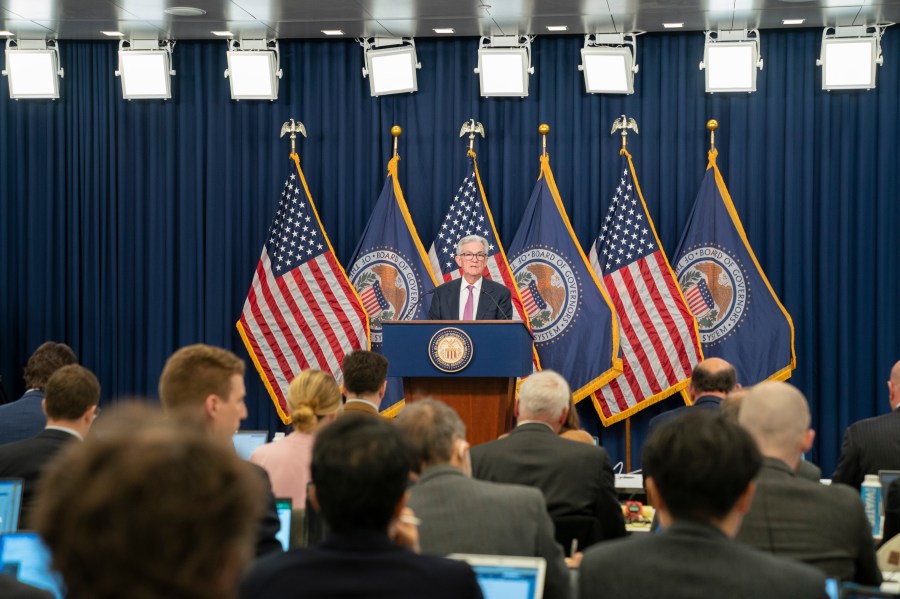5 biggest things Fed Chair Powell said about the banking crisis
Federal Reserve Chair Jerome Powell announced a 0.25 percentage point rate hike on Wednesday after a closely watched meeting of the central bank’s rate-setting committee, which many analysts had been hoping would result in a pause.
Prioritizing concerns about inflation over recent instability in the banking sector, which has spurred interventions from both the government and larger U.S. banks, Powell called the financial sector “sound and resilient.”
But he also dropped some hints that things may not be as peaceful as they appear on the surface and as government officials have been saying they are. Treasury Secretary Janet Yellen told a banking group this week financial conditions were stabilizing.
Powell also acknowledged that the failure of Silicon Valley Bank (SVB) that sparked the wider crisis in the banking industry happened despite the engagement of the Fed’s supervisory regulators.
Still rising: Fed hikes rates despite concerns over banking crisis
Here’s a recap of the most important things Fed chair Powell said after the latest rate hike and turmoil in the banking sector.

The Fed is now dealing with six regulatory alarm bells
Concerning the overall stability of the U.S. banking sector, Powell said the Federal Reserve is dealing now with six regulatory designations known as “matters requiring immediate attention” (MRIAs).
“I guess there were six of them,” Powell said.
“Those are serious. Those are serious regulatory [matters], particularly ‘immediate attention,” he added.
Powell did not name the institutions that had received those designations.
The Federal Reserve said MRIAs are issued in response to problems at banks that can lead to “further deterioration” and harm consumers.
“MRIAs are a call for more immediate action to address acute or protracted weaknesses that could lead to further deterioration in a banking organization’s soundness, may result in harm to consumers, or have caused, or could lead to, noncompliance with laws and regulations,” the Fed says on its website, noting that most of these “are resolved without the need to escalate.”
San Francisco-based First Republic Bank is seeking funding to stay afloat, even after it received $30 billion in deposits from large banks.
Silicon Valley Bank executives ‘failed badly’
Powell said that the broader financial system remains “sound and resilient,” calling Silicon Valley Bank an “outlier” when it came to the bank’s unusually high percentage of uninsured deposits and reliance on long-term assets that were undermined by the Fed’s rate hikes.
“At a basic level, Silicon Valley Bank management failed badly,” Powell said. “They grew the bank very quickly, they exposed the bank to significant liquidity risk and interest rate risk, they didn’t hedge that risk.”
Is the financial sector stable? Powell says banking system is ‘sound’ following SVB collapse
The bank suffered a rapid online and social media-driven bank run from its tech and venture capitalist depositors, which left it without enough funds to stay solvent. That prompted federal regulators to shut down the bank and protect all deposits.
Powell noted that federal supervisors were “very much engaged” with Silicon Valley Bank but were unable to stop its collapse. The Fed is investigating why that was the case, Powell said, adding that he welcomes independent investigations into regulatory blunders.
Lawmakers are already probing regulators’ role in the bank collapse. The House Financial Services Committee has called on the Government Accountability Office to investigate “regulatory, supervisory or examination failures.”
“When a bank fails, there are investigations, and of course we welcome that,” Powell said.

Fed might not be done hiking rates
Powell indicated that even higher interest rates could be coming as inflation remains hotter than expected. Fed officials expect at least one more rate hike this year, according to projections released Wednesday.
“If we need to raise rates higher, we will,” Powell said.
Higher interest rates restrict employers’ ability to borrow, slowing economic growth and reducing jobs and wages. The Fed aims to reduce demand so that prices come down.
Fed officials expect the unemployment rate to rise from 3.6 percent to 4.5 percent by the end of the year as higher interest rates weigh on growth. Powell called that figure a “highly uncertain estimate” but added that short-term economic pain is needed to ensure historic inflation doesn’t stick around.
“There are real costs to bring [inflation] down to 2 percent, but the costs of failing are much higher,” Powell said.
Sen. Elizabeth Warren (D-Mass.) tweeted after the press conference that Powell “made a mistake” by not pausing rates, pointing to the projected job losses.
Looking forward: How the banking crisis throws a wrench into Fed rate-hiking
“I’ve warned for months that the Fed’s current path risks throwing millions of Americans out of work. We have many tools to fight inflation without pushing the economy off a cliff,” Warren said.
Powell on Wednesday did not address the role that record corporate profits might play in keeping inflation high — dubbed “sellers’ inflation” by University of Massachusetts Amherst economists Isabella Weber and Evan Wasner.
A boost in the balance sheet isn’t ‘intended’ to change the Fed’s monetary policy
The Fed added more than $300 billion to its balance sheet last week as a number of banks sought money to stay solvent and pay back spooked depositors.
On the surface, those additions resemble the sort of quantitative easing that the Fed has been working to undo over the course of the past year in response to elevated inflation.
By taking money out of the financial system and raising interest rates, the Fed’s tighter monetary policies can slow down economic activity and lower prices.
Read more: Fed projects jobless rate to reach 4.5 percent by end of 2023
But Powell said Wednesday that the bulked-up balance sheet was only meant to address liquidity issues in the banking industry and that the money wasn’t working its way into the broader economy in the form of new loans, thereby potentially adding to inflation.
“The balance sheet expansions are really temporary lending to banks to meet those special liquidity demands created by the recent tensions. It’s not intended to directly alter the stance of monetary policy,” he said.

Credit conditions are tightening
The Fed said Wednesday that recent trouble in the banking industry is likely to result in “tighter credit conditions for households and businesses and to weigh on economic activity, hiring, and inflation. The extent of these effects is uncertain.”
Is your money safe? Regulators eye ways to insure all bank deposits
Powell elaborated on this point during his press conference, indicating it may be tougher for people to get mortgages and other types of loans in the near future.
“We think it’s potentially quite real,” he said. “And that argues for being alert as we go forward as we think about further rate hikes. For us, we will be paying attention to the actual unexpected effects from that.”
Copyright 2023 Nexstar Media Inc. All rights reserved. This material may not be published, broadcast, rewritten, or redistributed. Regular the hill posts









